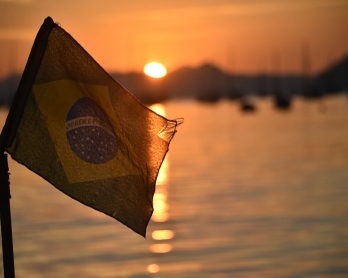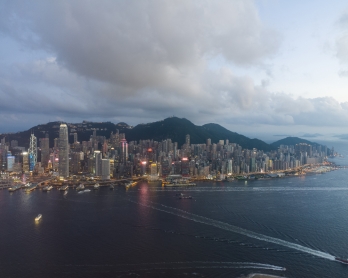Turkey's tumultuous times
ISTANBUL -- Flying back into Istanbul’s main airport a few weeks ago, I was pinned to my seat by the breathless beauty of the city, as if I was arriving for the very first time to the place that has been my home for almost half a decade.
The view was all the more intense for me as it was one of my last entries into Istanbul as a correspondent for AFP after four-and-a-half beautiful, inspiring and sometimes troubling years in Turkey. The shining channel of the Bosphorus, where giant tankers resembled Lego craft from the sky as they sailed through, opening into the Sea of Marmara where the Princes’ Islands surge out of the water like the back of a whale.
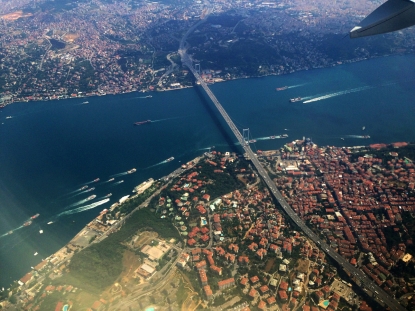 A photo of the Bosphorus strait and Istanbul's Asian (bottom) and European (top) shores taken from the window of a commercial plane flying on June 16, 2013. (AFP / Patrick Baz)
A photo of the Bosphorus strait and Istanbul's Asian (bottom) and European (top) shores taken from the window of a commercial plane flying on June 16, 2013. (AFP / Patrick Baz)Then the historic centre, where the Byzantine-built Hagia Sophia faces the Sultanahmet (Blue) Mosque in a perpetual dialogue, flanked by the Topkapi Palace that was home to the Ottoman sultans when their empire was as its zenith.
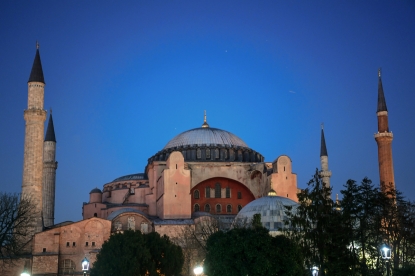 Hagia Sophia, December 9, 2017.
(AFP / Ozan Kose)
Hagia Sophia, December 9, 2017.
(AFP / Ozan Kose)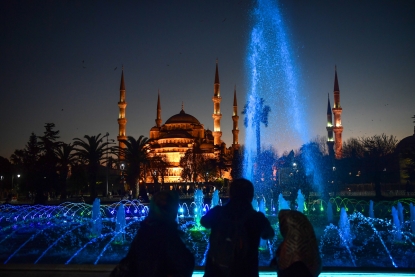 The Blue Mosque, December 9, 2017.
(AFP / Ozan Kose)
The Blue Mosque, December 9, 2017.
(AFP / Ozan Kose)
But as the plane was kept in holding pattern ahead of landing (an almost constant experience at the city’s clogged main airport) and I looked down at Istanbul, I was also struck by how much the city had changed in just the four-and-a-half years that I had lived in Turkey.
From the cabin window, I could see the third bridge spanning the Bosphorus which was opened by President Recep Tayyip Erdogan in 2016, a symbol of his huge and controversial ambition in giant infrastructure projects. A huge new mosque, of a size that rivals the great Ottoman edifices, now looms down from a hill in Camlica on the Asian side of the city, a sign of the swelling emphasis on Islam in Turkey, officially a secular state.
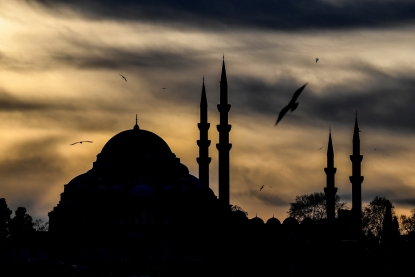 The Suleymaniye mosque, Istanbul, December 24, 2018.
(AFP / Ozan Kose)
The Suleymaniye mosque, Istanbul, December 24, 2018.
(AFP / Ozan Kose)Meanwhile, I saw how the entire port area from Kabatas to Karakoy on the European side has been razed to make way for a massive new dock development. And how Taksim Square, the heart of the modern city, is being transformed by a new mosque being built at breakneck speed, while a cultural centre named after Turkey’s founder Mustafa Kemal Ataturk has been knocked down although a new one, it is promised, will in time be erected.
These physical changes, so evident from a quick glance out of a plane cabin window, have been reflected by extraordinary shifts in Turkish politics and society that have taken place with stunning rapidity over the last five years.
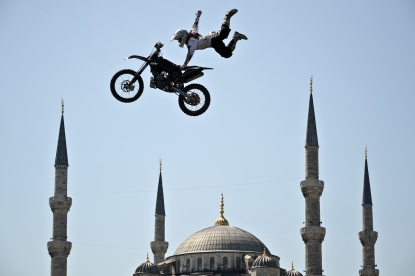 A German motocross biker performs in front of the Blue Mosque in Istanbul on April 5, 2009. (AFP / Dimitar Dilkoff)
A German motocross biker performs in front of the Blue Mosque in Istanbul on April 5, 2009. (AFP / Dimitar Dilkoff)When I arrived in Istanbul in June 2014, the head of the Turkish state ruled from a modest Ankara mansion and was not called Recep Tayyip Erdogan. The government was involved in tentative indirect peace talks with Kurdish militants to end a three-decade insurgency. And Turkish institutions were still thronged by supporters of a shadowy US-based Islamic preacher named Fethullah Gulen.
But over the course of the next five years, I would cover an extraordinary six national votes (two presidential polls, three sets of parliamentary elections and one referendum), a failed coup bid and horrific terror attacks that together would shape Turkey’s destiny.
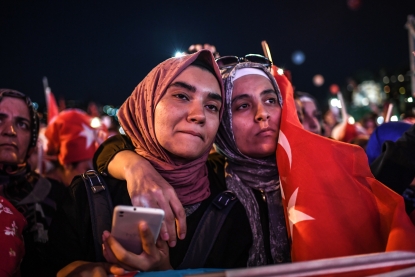 Women listen to the names of people killed during a 2016 coup attempt, at the July 15 Martyrs Bridge on July 15, 2018, the coup's second anniversary. (AFP / Ozan Kose)
Women listen to the names of people killed during a 2016 coup attempt, at the July 15 Martyrs Bridge on July 15, 2018, the coup's second anniversary. (AFP / Ozan Kose)Looking back, it’s overwhelming how much changed in such a short piece of time. In previous postings as an AFP correspondent in Iran and Russia, I had the privilege of covering increasingly vibrant societies that are governed in very specific ways and witnessing at first hand the tensions that this causes.
But there I always felt I was living in societies and systems where the rules of the game, for the moment at least, had already been set. But over the last half decade in Turkey, I have watched them being created and have witnessed decisive changes in the way that a country is governed.
Shortly after my arrival in August 2014, Erdogan, previously premier, was elected president in the first direct elections for head of state in Turkey’s history. He quickly moved into a vast new presidential palace that was being built in Ankara in a giant symbol of the new power of the head of state. The peace process broke down as the Kurdish militants broke a ceasefire following jihadist attacks and the security forces embarked on a remorseless campaign to crush them. And already in late 2014 the authorities began to purge alleged Gulen supporters, a process that intensified into a mass crackdown from July 2016 following the failed coup blamed on his group.
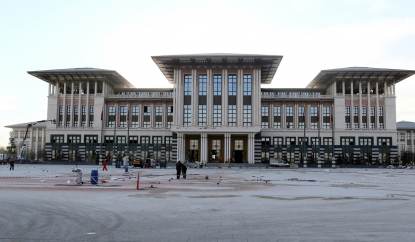 The presidential palace in Ankara, October 22, 2014.
(AFP / Adem Altan)
The presidential palace in Ankara, October 22, 2014.
(AFP / Adem Altan)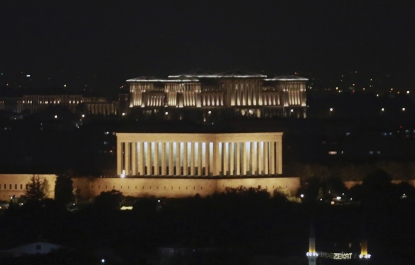 The new presidential palace of Turkish President Recep Tayyip Erdogan towers above the mausoleum of Turkey's founder Kemal Ataturk, Ankara, July 3, 2016.
(AFP / Adem Altan)
The new presidential palace of Turkish President Recep Tayyip Erdogan towers above the mausoleum of Turkey's founder Kemal Ataturk, Ankara, July 3, 2016.
(AFP / Adem Altan)
Since the failed coup bid and Erdogan’s victory in the April 2017 referendum that formalised his new powers as president, I watched as his grip tightened on the country, including on the domestic media. This was clearly apparent in the newspapers that were delivered to the office every day and the television channels that blare constantly from the walls. Some newspapers disappeared after being banned, others like the Hurriyet daily changed their tone significantly following ownership changes. Meanwhile even private television channels like CNN-Turk and NTV toed the government line ever closer.
After arriving from Moscow, I also watched with particular fascination the unfolding drama of Turkey’s relationship with Russia, which swung from a suspicious pragmatism, to outright enmity and then into a key alliance in the space of a few years.
Erdogan and President Vladimir Putin flung no-holds-barred insults at each other in the crisis that followed the shooting down of a Russian warplane by Turkish jets over Syria in November 2015. But after the relationship was patched up in summer 2016, Erdogan and Putin rediscovered their bromance and the intense cooperation with Moscow made the partnership with Russia, along with Turkey’s alliance with Qatar, arguably its most significant diplomatic relationship.
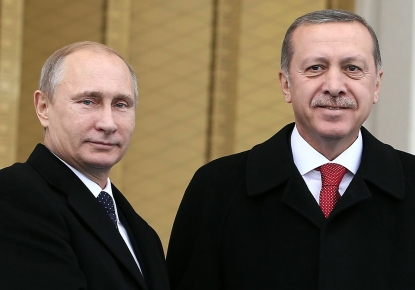 Russian President Vladimir Putin (left) with Turkish counterpart Recep Tayyip Erdogan on December 1, 2014, at the entrance of the presidential palace in Ankara, December 1, 2014.
(AFP / Adem Altan)
Russian President Vladimir Putin (left) with Turkish counterpart Recep Tayyip Erdogan on December 1, 2014, at the entrance of the presidential palace in Ankara, December 1, 2014.
(AFP / Adem Altan)I watched amazed as Erdogan notched up more telephone calls and face-to-face meetings with Putin than with any other leader. In 2018 alone, Putin and Erdogan talked an astonishing 25 times -- 18 times by telephone and seven times face-to-face.
And, meanwhile, the changing face of Istanbul was apparent even from my back window, which afforded me the luxury of a partial view of the Bosphorus. When I arrived in the summer of 2014, an unending procession of giant cruise ships would moor at the port area below.
These vanished as Turkey became increasingly shaken by terror attacks from the summer of 2015. Then diggers moved in to create a vast new dock and portside area known as Galataport. I watched from my window as the acclaimed Istanbul Modern art museum, opened in 2004 in an old port depot and seen as a symbol of the new Istanbul, was demolished with breathtaking speed. The museum moved to temporary premises and a new building is planned in its place. But it felt like the end of an era.
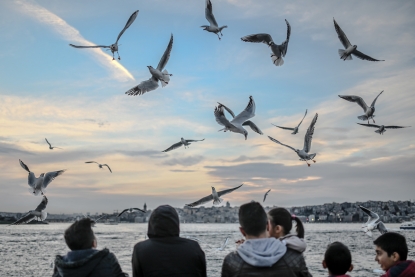 People feed seagulls as they stand at the back of Kadikoy ferry crossing the Bosphorus in Istanbul on January 29, 2019. (Photo by BULENT KILIC / AFP) (AFP / Bulent Kilic)
People feed seagulls as they stand at the back of Kadikoy ferry crossing the Bosphorus in Istanbul on January 29, 2019. (Photo by BULENT KILIC / AFP) (AFP / Bulent Kilic)Friends came and left with the changing of the atmosphere. A large number of mainly foreign acquaintances decided in 2016 that enough was enough in the tense atmosphere after the coup that was weighed by the crackdown and more terror attacks. Some (but not all) Turkish friends are now making their own plans to leave, uncomfortable with the fast pace of change in their own society. But after being almost absent in the dark months of terror-blighted 2016, Western tourists are now making a comeback across the country, joined by ever increasing numbers from the Gulf and eastern Asia.
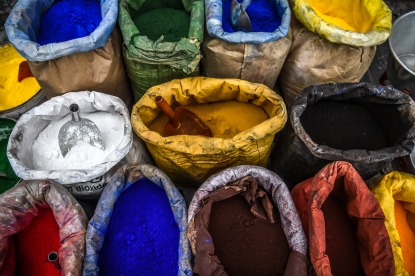 Pigment powder in Istanbul's historical Karakoy district, February 22, 2017. (AFP / Ozan Kose)
Pigment powder in Istanbul's historical Karakoy district, February 22, 2017. (AFP / Ozan Kose)I don’t doubt that this half decade will be seen by future historians as a key crossroads in the history of modern Turkey. In these years under Erdogan, Turkey revived its Ottoman-era ambition on the international stage not just in neighbouring countries like Syria and Iraq but also to the west in the Balkans and notably in Africa. The step towards Russia may prove a decisive moment in Turkish foreign policy. Erdogan has clearly staked his claim to be leader of historical importance comparable to Ataturk, whose giant image normally hangs next to that of the president at rallies, with both pictures of an identical size.
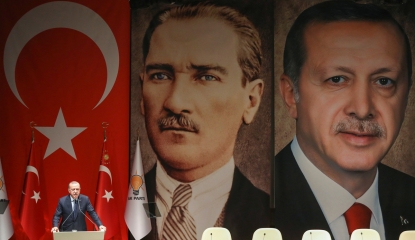 Turkish President Recep Tayyip Erdogan addresses provincial heads of his Turkish ruling Justice and Development Party (AKP) in front of a giant portrait of him and one of Mustafa Kemal Ataturk, the founder of modern Turkey, on January 11, 2019 at the party's headquarters in Ankara. (AFP / Adem Altan)
Turkish President Recep Tayyip Erdogan addresses provincial heads of his Turkish ruling Justice and Development Party (AKP) in front of a giant portrait of him and one of Mustafa Kemal Ataturk, the founder of modern Turkey, on January 11, 2019 at the party's headquarters in Ankara. (AFP / Adem Altan)Mosque-building and the increasing importance of religion-based schools dramatically upped the emphasis on Islam in official life, although some key changes such as allowing Turkish female police officers to wear a headscarf simply brought Turkey into line with other European countries. And Erdogan saw off threats to his grip, notably the failed 2016 coup which claimed the lives of some 250 Turkish citizens and whose defeat has now joined the pantheon of heroism in the official narrative of Turkish history.
Yet I am also sure the next five years will be at least as decisive, as Turkey and Erdogan prepare to mark the 100th anniversary of the foundation of the modern republic in 2023. It’s sad for me to leave at this point, with so much still unwritten, but there is a point where a book must be closed.
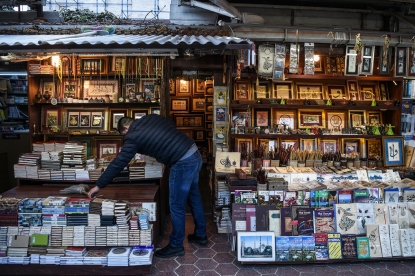 A book seller of Istanbul, February 24, 2017.
(AFP / Ozan Kose)
A book seller of Istanbul, February 24, 2017.
(AFP / Ozan Kose)When I sit in a cafe somewhere in western Europe reflecting on Turkey, it is not covering the great events that I miss. For all the fascination of reporting on Erdogan, whose personality so dominates Turkey (my first move in the morning before even getting out of bed was to check his schedule on my phone), it’s the simple pleasures of daily life that I miss.
Going for a run as dawn breaks by the Bosphorus, before the daily urban chaos wakes up, when the city feels like it’s yours. Taking a ferry across the strait, sipping a tea, sitting in my favored position on a bench at the side with my feet resting on the rails, as the sea washes by my shoes.
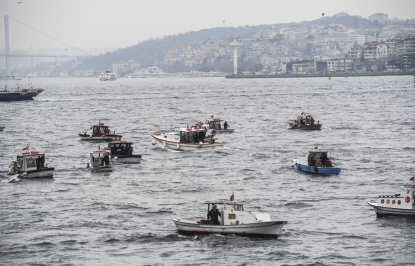 Fishermen sit aboard their crafts in the Bosphorus on February 22, 2017 in Istanbul. (AFP / Bulent Kilic)
Fishermen sit aboard their crafts in the Bosphorus on February 22, 2017 in Istanbul. (AFP / Bulent Kilic)Watching a society that is still fascinatingly diverse, where in the space of a 15 minute taxi ride across Istanbul (assuming there is no traffic...) you can move from a European, secular district where alcohol is freely served to an area where the most pious Islam dominates. And, above all, travelling across Turkey, discovering beautiful and historically fascinating sites, in the company of the most warm-hearted and hospitable people you can ever meet. Much changes, but some things in Turkey and Istanbul I hope are eternal.
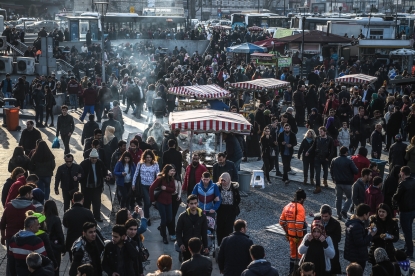 People walk among food stalls in Istanbul's Eminonu district on February 19, 2017. (AFP / Ozan Kose)
People walk among food stalls in Istanbul's Eminonu district on February 19, 2017. (AFP / Ozan Kose)Next time I travel to Istanbul, I will experience yet another change. There will likely be no airborne view of the historic peninsula as the plane prepares to land or (hopefully) a long holding pattern, as a giant new airport by the Black Sea should by then be fully operational, after several delays. The new facility, named simply as Istanbul Airport and replacing Ataturk International Airport as Turkey’s aviation hub, is one of the most ambitious of Erdogan’s self-styled “crazy projects”. Another major and heavily symbolic change, and, I am sure, not the last.
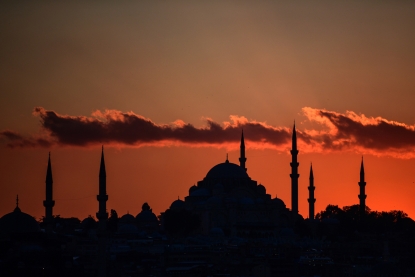 The Suleymaniye Mosque (right) and the New Mosque, at sunset in Istanbul, October, 2017.
(AFP / Ozan Kose)
The Suleymaniye Mosque (right) and the New Mosque, at sunset in Istanbul, October, 2017.
(AFP / Ozan Kose)


